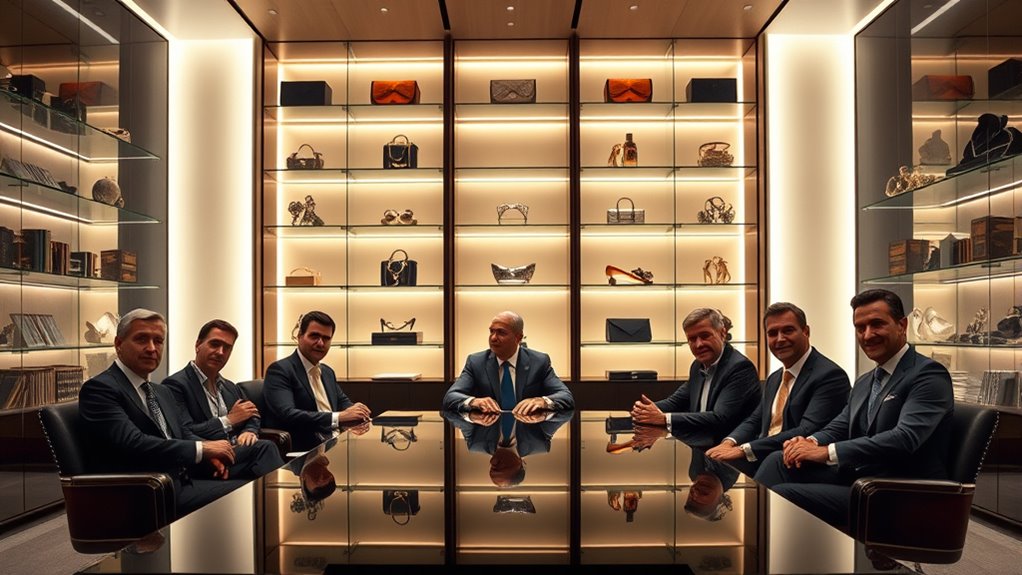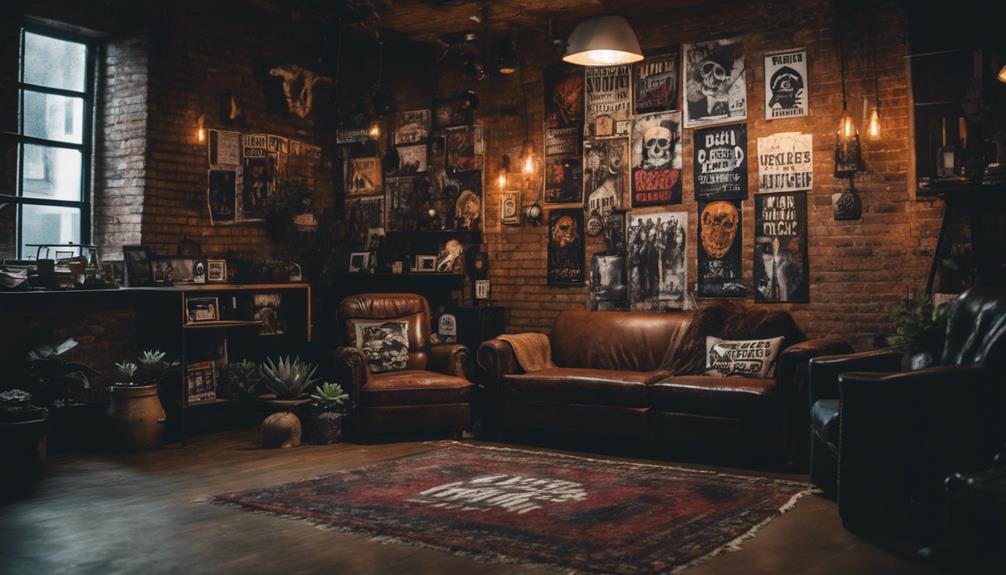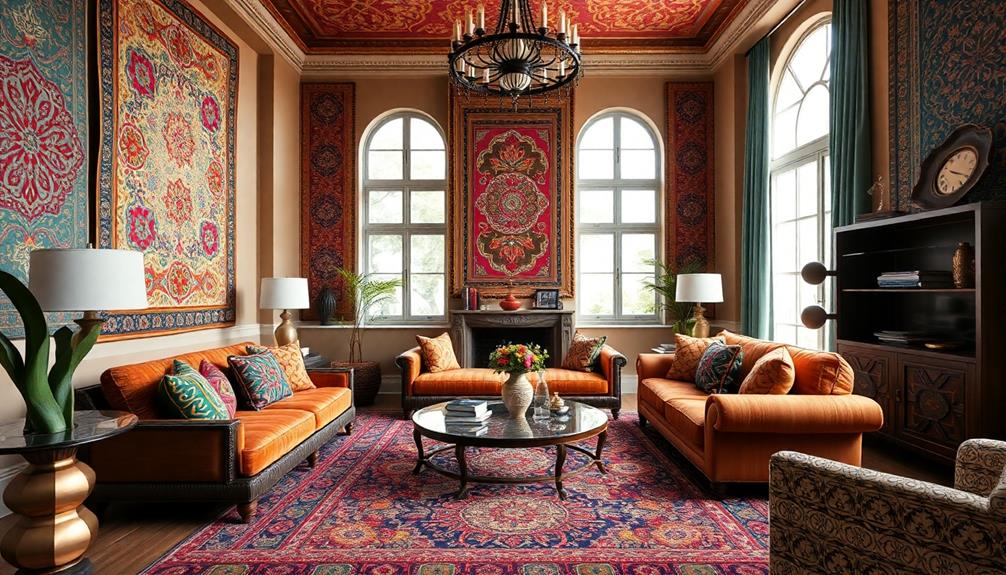Armani’s succession plan clearly favors luxury industry giants like LVMH by guiding ownership transfers to strategic players with strong ties to the brand. The plan keeps voting rights with key stakeholders, ensuring Armani’s legacy remains independent and secure, even as shares change hands. It’s structured to attract heavyweight luxury firms, fostering alliances that benefit the brand’s future. If you look further, you’ll see how this approach safeguards Armani’s heritage while opening doors to major industry leaders.

Armani’s upcoming succession plan is shaping the future of one of the world’s most iconic luxury brands by favoring industry giants like LVMH, L’Oréal, and EssilorLuxottica. As you follow the plan, you’ll see how it strategically positions the company for continued dominance by aligning with established industry leaders. Initially, the Armani Foundation will hold 10% of the shares, serving as a key stakeholder committed to the brand’s philanthropic legacy. Dell’Orco, inheriting a 30% stake, will wield significant influence, especially since voting rights are initially controlled by Dell’Orco and the Foundation together, totaling 70%. This voting bloc guarantees that, even with the share distribution, control remains concentrated among these main players until a major sale occurs.
Armani’s succession plan consolidates control with key stakeholders, ensuring brand legacy and strategic industry alliances.
The remaining 60% is divided equally among Armani’s family members—sister Rosanna Armani, nephew Andrea Camerana, and nieces Silvana and Roberta Armani—each holding a 15% stake. These heirs have no voting rights until the shares are sold, but they’re still economically invested in the company’s future. The plan’s design emphasizes stability; post-transaction, the Foundation’s stake cannot drop below 30.1%, maintaining a significant influence on corporate decisions and safeguarding the brand’s legacy. Additionally, the design intentionally creates a cohesive palette for future management, ensuring that the brand’s vision aligns with its heritage.
A key component of this plan is the mandated sale of shares. The heirs are required to sell 15% within 18 months of Armani’s passing, ensuring a swift infusion of capital and potential new ownership. Subsequently, they must offload between 30% and 54.9% over three to five years, with the sales restricted to a single buyer. The sale’s proceeds are capped, with heirs netting no more than 45% of the company’s value, and Dell’Orco leading the process, receiving 32% of the proceeds. This structure aims to attract heavyweight buyers, with the primary target being luxury conglomerate LVMH. Other potential buyers include L’Oréal and EssilorLuxottica, especially those with existing ties to Armani, highlighting a preference for strategic industry players over public market entries.
Post-sale, the voting control remains with Dell’Orco and the Foundation, who retain 70% of the votes until the first major transaction. Afterwards, the Foundation’s ownership will stay above 30.1%, ensuring they continue to influence decisions. This separation of voting rights from economic interests prevents fragmentation and secures continuity. The heirs, meanwhile, retain economic stakes but not voting power until the shares are sold, reinforcing a controlled transition of ownership. Overall, the succession plan aims to bring in industry giants, secure the brand’s future, and sustain Armani’s legacy by fostering strategic alliances with the world’s leading luxury titans. Additionally, the plan includes measures to maintain brand independence, ensuring that the core identity remains intact despite future ownership changes.
Frequently Asked Questions
How Will Armani’s Brand Identity Change With New Ownership?
Your Armani brand will likely see some evolution under new ownership, especially if a luxury conglomerate like LVMH or L’Oréal takes control. While the core aesthetic and values may stay intact due to strong governance and family influence, expect possible shifts in brand positioning, marketing strategies, and product offerings. Collaboration with larger luxury groups could introduce innovation, but there’s also a risk of diluting Armani’s distinctive style and exclusivity.
What Are the Potential Risks of Succession by Luxury Giants?
You face risks when luxury giants succeed brands like Armani. Leadership instability can erode brand identity, confuse consumers, and hurt sales. Family succession might lead to nepotism or skills gaps, while conglomerate plans risk diluting brand autonomy. Social media amplifies reputational risks, and poor leadership choices could disrupt strategic direction. To protect your investment, guarantee transparent succession planning, maintain brand integrity, and actively manage digital reputation during leadership transitions.
Will Armani Expand Into New Product Categories Under New Leadership?
Think of Armani as a master chef, always experimenting with new ingredients. Under new leadership, you can expect the brand to expand into additional categories like skincare, fragrances, and accessories, blending tradition with innovation. Recent launches of advanced skincare and diverse fragrances show their willingness to diversify. This strategic move aims to satisfy evolving consumer desires, just as a chef refines recipes to delight even the most discerning palates.
How Does This Succession Impact Armani’s Global Market Strategy?
Your understanding is correct: the succession plan considerably reshapes Armani’s global market strategy. By partnering with major luxury and beauty conglomerates, you gain access to broader markets and enhanced distribution channels. Meanwhile, internal leadership ensures the brand’s creative integrity remains intact. This balance allows you to expand into new territories, diversify product offerings, and strengthen Armani’s position as a leading global luxury brand, all while maintaining its heritage and exclusivity.
What Are the Long-Term Implications for Armani’s Brand Exclusivity?
You might wonder if Armani’s brand will stay exclusive long-term. The answer is yes, thanks to strict ownership controls, veto rights, and careful succession planning. By keeping key stakeholders within trusted circles and involving luxury giants like LVMH, Armani safeguards its high-end image. This strategic setup prevents dilution, ensures continuity, and preserves the allure of exclusivity, so your perception of Armani as a rare, luxury icon remains intact for generations.
Conclusion
So, as you watch Armani’s future unfold, it seems like the luxury titans are really the ones set to take the reins. Maybe it’s because their power and influence align perfectly with Armani’s legacy, or perhaps it’s just the natural order of the high-end world. Either way, you can’t help but wonder if this trend will continue—after all, in luxury, dominance often equals survival. It’s a game where only the strongest thrive.









